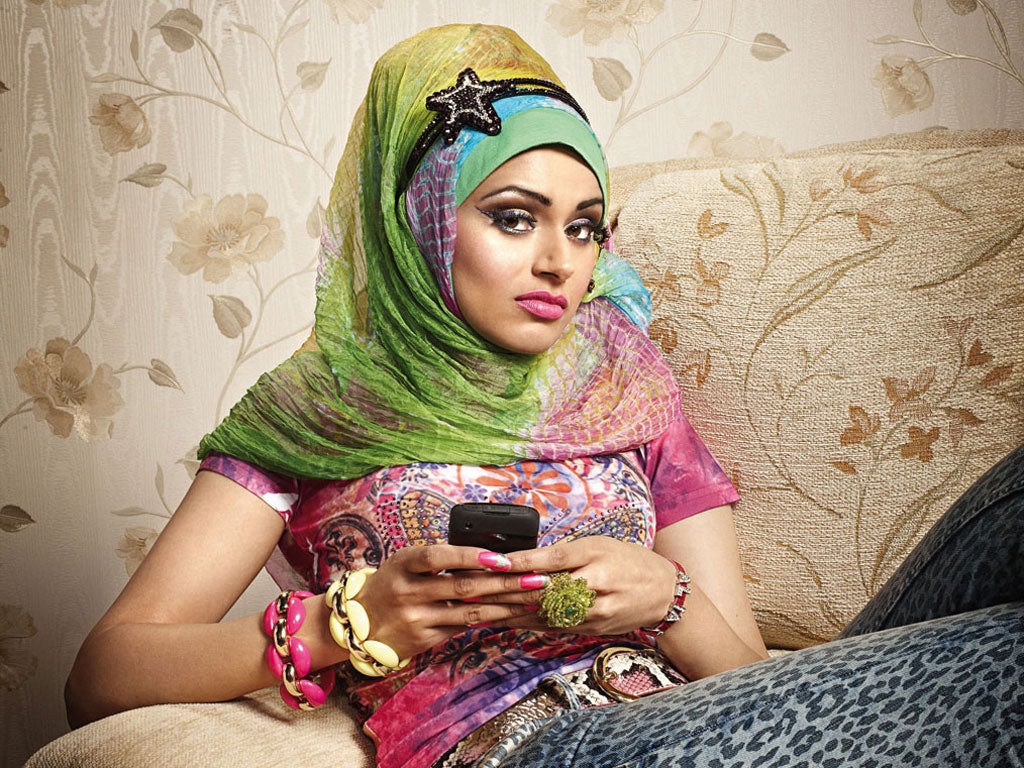Citizen Khan’s Alia: How the hijab got sexy
BBC1’s Citizen Khan has received several complaints since its debut, but our writer believes the makers of this controversial show have got one thing right.


Your support helps us to tell the story
From reproductive rights to climate change to Big Tech, The Independent is on the ground when the story is developing. Whether it's investigating the financials of Elon Musk's pro-Trump PAC or producing our latest documentary, 'The A Word', which shines a light on the American women fighting for reproductive rights, we know how important it is to parse out the facts from the messaging.
At such a critical moment in US history, we need reporters on the ground. Your donation allows us to keep sending journalists to speak to both sides of the story.
The Independent is trusted by Americans across the entire political spectrum. And unlike many other quality news outlets, we choose not to lock Americans out of our reporting and analysis with paywalls. We believe quality journalism should be available to everyone, paid for by those who can afford it.
Your support makes all the difference.BBC1’s Citizen Khan has received complaints not least for suggesting that Pakistani households are headed by swindling, male chauvinists who keep women under their yoke. But the production team hit the nail on the head with personalities like Alia, played by Bhavna Limbachia.
As a practising South Asian Muslim, I know many girls like her. The scenes which show Alia pretending to be engrossed in the Quran’s recital and covering her head with the hijab, just to keep up appearances in front of her father, are indeed true to the behaviour of some young Muslim women who scorn what they see as the hijab’s drab and frumpish look.
Student life at university opened my eyes to a number of Muslim girls, for whom a holy charade continued in fits and starts. The web of deceit woven by those who treated the hijab as a flimsy camouflage, shared much in common with Alia’s portrayal in Citizen Khan. It was common to find young Muslim women duping their fathers into believing they were veiled outside the home, when, in actual fact, they could be spotted with peek-a-boo fabric at beaches and party jams, soaking up the sun, sex and booze.
Even in my circles, there are girls who see the hijab as a bartering chip and win favour with their fathers through flattery, only to later fly in the face of tradition and jettison Islamic morals for a slightly more seductive gospel. Feigning obedience and working their way into daddy’s good books through a mixture of bluff and charm is a survival strategy for the Alias of this world. I’m certain director Adil Ray knows all too well those Muslim fathers, heaping praise on their daughters’ covenant with the Almighty but ultimately unsuspecting of their double shuffle.
Non-Muslims are likely to ask why some Muslim girls resort to such amateurish feats of make-believe, without confronting anxieties about their sexuality and identity head-on, as most responsible young adolescents are expected to do. What I can say as partly responsible – having worked and studied with a number of South Asian Muslim youths – is the unspeakable frustrations caused by the intense sexual repression in their homes. The agony which some Muslim women in particular find themselves in, hailing from conservative and teetotal families, which preach a very coy and shameful attitude towards sex, can generate confused notions of sexuality like Alia's.
But Alia’s character is also a revealing insight into a deeper mutation in the Muslim gender quake. Not every case is as discreet and cunning as hers. Simply, there are a considerable number of hijab-clad girls who are using fashion to express their own, slightly milder, version of today’s obsession with raunch.
To illustrate to non-Muslims the pragmatic stride towards risqué which some British Muslim women are taking, I would have to describe what a typical Eid occasion looks like in London’s Tower Hamlets, an area with one of the UK’s largest Muslim populations. It’s usually the equivalent of a Prêt-à-Porter Paris fashion week, where Muslim girls demand an equal share of the spoils enjoyed by those gracing the covers of Cosmopolitan and Elle.
Last Eid I remember the swarms of hijab-clad women, some adorned in salwar kameez while others sported plunging necklines, who were greeted by a chorus of catcalls outside East London Mosque. The sounds drowned out the calls to prayer usually heard bellowing from the minaret. Bursting with flesh to curry male approval, they were lapping up the gazes not only from ogling construction workers but also loutish Muslim youths, who whisked them into a fleet of pimped-up super cars. The more traditional bystanders could manage only a few garbled phrases at this tour de force of carnality.
These girls were certainly not deterred by senior members of the community, who could easily, as is common in many South Asian cultures, admonish them and reveal their shenanigans to their parents. Perhaps these girls are just fed up of the morality police, where everything from behaviour to dress must adhere to dogmatic dos and don’ts? I can’t unpack their psychology, but I do recognise how they present the more puritan Muslims with a hard-hitting reality: that some Muslim girls are just as immersed in today’s superficial culture as anyone else.
For many of the devout Muslim men I have spoken to, “sisters” who take delight in being gawked and gaped at without fear of censure are beyond redemption. I think that’s unfair and smacks of bigotry, especially when these “sisters” often grow up in an environments where opportunities to discuss sexuality are closed. While their inability or unwillingness to wear the hijab as traditionalists would wish is ironice, it reveals a significant demographic of burlesque hijabis, enamoured by a kitsch sartorial line. In my view, basking in the romanticism that every hijab-clad girl deserves a standing ovation for being the pick of creation is unhealthy and immature. Many approach fashion in the spirit of playfulness and are simply seeking ways in which their hijab and predilection for sex appeal can co-exist. There’s very little Muslim men can do about that.
So Alia’s case is telling for many reasons. Although Citizen Khan provoked indignation for offending the British Muslim consensus on many fronts, sometimes it takes self-deprecating banter to blow the whistle on a culture’s idiosyncrasies. Credit must be given to Adil Ray for not sparing any sacred cows and shining light on the conundrum of some British Muslim women under the patriarchal cosh.
Join our commenting forum
Join thought-provoking conversations, follow other Independent readers and see their replies
Comments